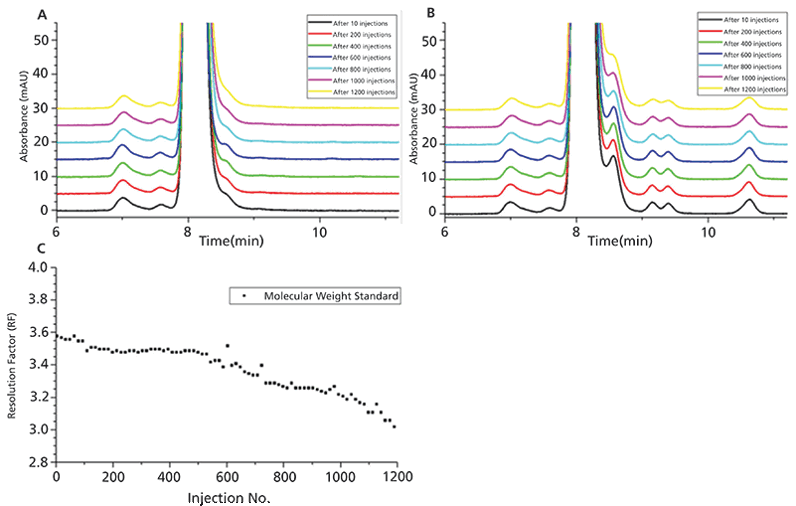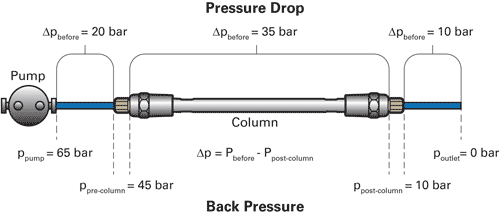General FAQs on HPLC and UHPLC columns
How do I extend column lifetime in HPLC?
Column lifetime refers to the number of injections a column can take and give reasonable and reproducible separations. Thus it determines how long a column lasts. The lifetime of HPLC columns differs with its chemistry, the samples analyzed on it and the conditions (temperature, composition of mobile phase ...) it is exposed to. However, there are ways to improve column lifetime:
- Avoid unnecessary buffer changes
- Avoid unnecessary removal and reconnection of the column from/to the HPLC system
- Avoid temperature changes (e.g., due to sun exposure)
- Use a guard column (see below: guard column)
- Apply a continuous flow to the column, also when not in use
- If a column is not used for a longer time (> 7 days): store in the shipping solvent which is given in the operating and conditions sheet for each column and put into the packaging provided by the supplier in order to prevent from knocks
Lifetime analysis of a UHPLC size exclusion column TSKgel UP-SW3000
|
 |
Lifetime of the TSKgel UP-SW3000 column was tested by (A) injecting non-stressed, and (B) stressed material of an antibody derived molecule, as well as (C) regularly running a molecular weight standard in between. The resolution factor of the standard was determined according to the European Pharmacopoeia between ovalbumin (44 kDa) and gamma globulin (158 kDa).
What is the pressure limit for an HPLC column?
An HPLC system builds up the pressure with its pump. This is necessary to guide the mobile phase and the sample through the low-diameter tubings to the column and then to the detector. Accordingly, these are also the sections that must withstand the pressure. The pressure the column is exposed to is the pressure the pump generates in total minus the system pressure without column. The limit for the column is dependent on the mechanical stability of the column packing and the stability of the column hardware. For each TSKgel column, the maximum pressure change is given in its operating conditions and safety sheet (ODS).
Figure 2: Back pressure generated by the HPLC instrument and the column. Actual figures vary with instrument and column.
|
 |
How do I determine the injection volume for an HPLC column?
The injection volume is the volume of sample which is injected onto an HPLC column. For adsorptive chromatographic methods (such as ion exchange, hydrophobic interaction or affinity chromatography), the volume depends on the dynamic binding capacity of the resin and on the concentration of the sample. In contrast, chromatographic modes that are based on distribution (such as size exclusion chromatography) work with a sample volume between 0.1-1% of the bed volume. For analysis, lower volumes often result in better separations, as long as the analyte concentration is high enough to be detected.
How to store HPLC columns?
If it is necessary to store a column, it is recommended to use the shipping solvent, which is indicated in the operating conditions and safety sheets (OCS) of each product. The column should be put back into the column packaging as this safes it from mechanical knocks. A column should only be stored if it is not used for 7 days or if the place is needed to use another column. Otherwise, the column should be left in the system with a low flow (e.g. 0.05 ml/min) applied.
How to clean an HPLC column?
Methods to clean HPLC columns are as diverse as the columns themselves. It depends on the chemical stability of a column, on the kinds of interactions that are expected to be responsible for molecules to stick to a column. Appropriate cleaning procedures for an HPLC/UHPLC column are described in their operating conditions and safety sheets (OCS) and in our “HPLC and UHPLC column care and maintenance” section.
What is a guard column and is a guard column necessary?
A guard column is a small column between the injector and HPLC column with the same packing material and inner diameter as the analytical column. It prevents particulates and contaminations to reach the analytical column and thus extends its lifetime. These are the benefits of using a guard column:
- reduces unspecific interactions on the main column
- increased lifetime of the main column
- reduces possible pressure boosts
- equals pH, when sample and mobile phase is different
A guard column should be used if the column lifetime should be extended or if the sample is complex.
Which fittings can I use with TSKgel® columns?
Mainly stainless steel or PEEK: columns: 10/32 female inlets and outlets, fittings: recommend “fingertight” style plastic fittings with PEEK tubing (always 1/16” OD)
Rare: glass: These columns employ ¼-28 female threads both in and out of the column. ¼-28 fittings are typically used with 1/8” OD Teflon tubing for low-pressure FPLC applications.
What is the lot numbering rule for TSKgel columns?
The column numbering system consists of 2 parts:
- the lot number which is the alphanumeric sequence after the dash in the column number
- the column serial number which is unique to that specific column
- Example: 501EA00362E, Lot No: 501EA, Serial No: 00362E
The lot number refers to a production run of packing materials.